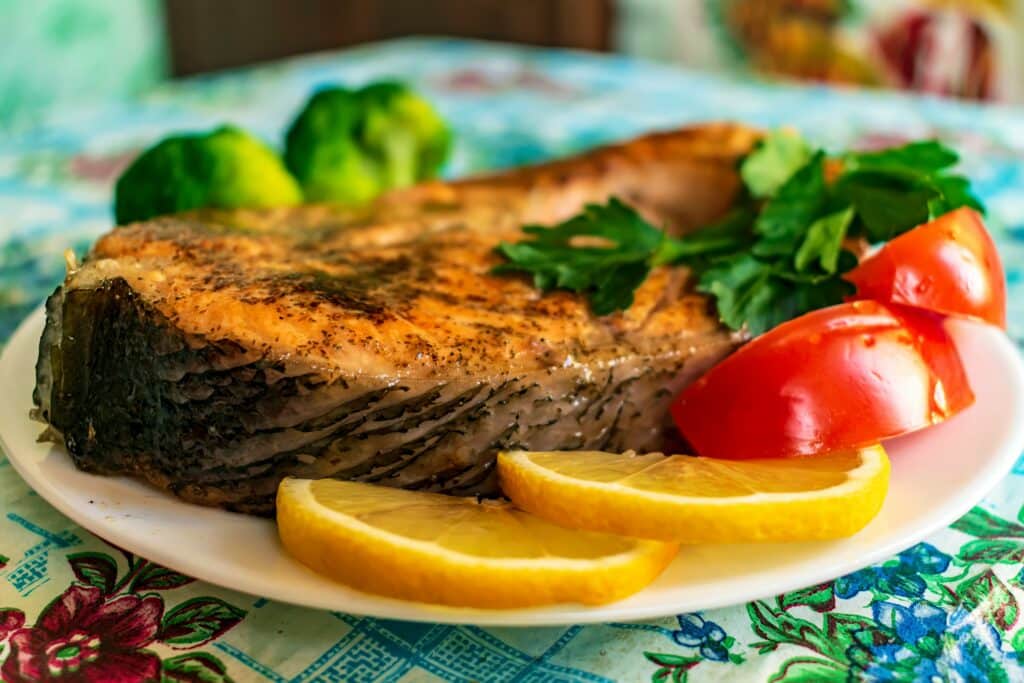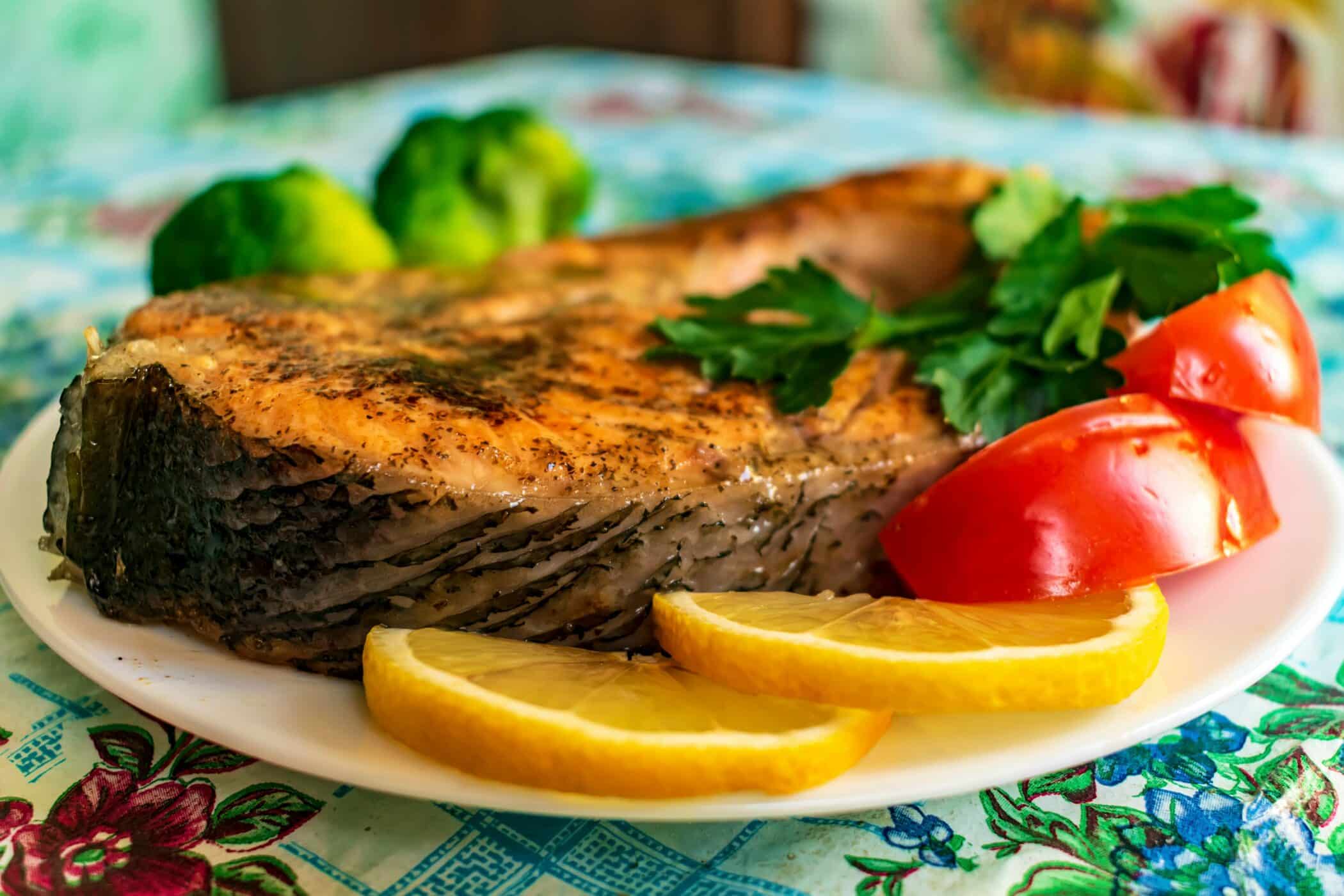
Finding the ideal diet for your exact taste can be a tiring process. Luckily, there are numerous options, and the pescatarian diet might be exactly what you’re looking for.
Pescatarian meals are loaded with nutrients, excellent for weight management, and perfect for seafood and fish lovers. If you fit in that category, you’ll definitely be interested in what this diet offers.
Table of Contents
What are pescatarian meals?
Pescatarian meals are a part of a plant-based diet with added seafood for protein. People who are pescatarian don’t eat meat from land animals, but they do eat fish and other kinds of seafood. People choose this diet for different reasons, such as health, the environment, or their personal preferences.
Pescatarian meals usually have many fruits, veggies, grains, nuts, and seeds. It’s similar to what vegetarians or vegans eat. However, adding fish and seafood has many health benefits, giving them more protein, omega-3 fats, and vitamins. The most common seafood choices for pescatarian meals are:
- salmon;
- trout;
- tuna;
- shellfish;
- shrimp;
- crabs.
There’s a lot of variety in pescatarian meals that will cater to everyone’s taste. It can range from salads and bowls to pasta and stir-fries with fish or seafood.
Is it easy to go pescatarian?
Switching to a pescatarian diet’s ease depends on your preferences and dietary habits. It can be easier if you enjoy seafood and plant-based foods, but factors like cooking skills or access to seafood play an important role.
Pescatarian meals are more flexible than strict vegetarian or vegan diets. Meal planning will be much simpler with fish and seafood since they’re excellent protein sources.
However, some areas don’t have access to fresh seafood, and getting it can be challenging. Additionally, you should be comfortable with cooking and experimenting with new recipes.
If you aren’t a big fan of cooking, you can make the switch more convenient with options like food delivery services. They offer diverse pescatarian dishes, from flavorful seafood options to plant-based creations.
On top of that, the meals are delivered right to your doorstep. This can eliminate concerns about finding fresh ingredients or mastering new recipes. That makes the transition to a pescatarian lifestyle smoother and more enjoyable.
When you switch to a pescatarian diet, it’s a good idea to do it gradually. Most people find it easier to transition by reducing their consumption of other meats over time. This gradual shift allows your taste preferences and digestive system to adapt.
Finally, pay attention to crafting a balanced diet that meets your nutritional needs. Ensure you get enough protein, essential fatty acids, vitamins, and minerals.
Is a pescatarian diet healthy?
Pescatarian meals are healthy due to their inclusion of nutrient-rich seafood. It provides lean protein, omega-3 fatty acids, essential vitamins, and minerals and focuses on plant-based foods. By promoting heart health and reducing saturated fat, this diet contributes to lower cholesterol levels and a decreased risk of cardiovascular diseases.
Lean protein sources
Fish and seafood are exceptional sources of lean protein. They provide essential amino acids that support muscle growth and help your body run efficiently.
Omega-3 fatty acids
Fatty fish like sardines or salmon are rich in omega-3 fatty acids. They are known for their heart-healthy benefits. Omega-3s provide numerous advantages for health, such as promoting brain health and reducing the chances of heart disease.
Nutrient diversity
A pescatarian diet is all about including variety in your meals. That includes fruits, veggies, whole grains, nuts, seeds, and legumes. These diverse foods are packed with nutrients that contribute to your overall health.
Reduced saturated fat
Consuming meat from land animals will contribute to higher levels of saturated fats, which can lead to several health issues. By opting for pescatarian meals, you can lower your intake of saturated fats, thus decreasing your risk of those health issues.
Vitamins and minerals
Seafood provides essential nutrients such as vitamin D, B12, iodine, selenium, and zinc. These nutrients are necessary for various bodily processes, bone health, and immune function.
Weight management
A pescatarian diet is an excellent option for managing and maintaining a healthy body weight. Of course, as with any other diet, focusing on whole foods and portion control is crucial.
Pescatarian meal ideas
Shrimp and avocado salad
For this simple and delicious pescatarian option, you’ll need:
- eight to ten cooked shrimp peeled and deveined;
- one avocado, diced;
- two cups of mixed greens;
- half a cup of cherry tomatoes, halved;
- one-fourth of a red onion, thinly sliced;
- one tablespoon of lemon juice;
- one tablespoon of olive oil;
- salt and pepper to taste.
Grab a bowl to combine the ingredients. Add the cooked shrimp, diced avocado, mixed greens, cherry tomatoes, and sliced red onion. Drizzle the salad with lemon juice and olive oil. Toss everything gently to combine. Finally, season the salad with salt and pepper to taste.
Tuna or salmon sushi rolls
If you’re a sushi fan, you’ll be blown away by this flavorful delicacy. You’ll need the following ingredients to make it:
- two sheets of nori (seaweed);
- about one cup of cooked sushi rice;
- three to four slices of tuna or salmon;
- one-fourth of a cucumber, julienned;
- one-fourth of an avocado, sliced;
- soy sauce for dipping;
- wasabi and pickled ginger for serving.
Lay a bamboo sushi rolling mat on a clean surface. Place a sheet of nori, shiny side down, on the mat. Moisten your hands with water to prevent sticking, and spread an even layer of sushi rice over the nori, leaving about half an inch of nori uncovered at the top edge. Lay the slices of tuna or salmon, cucumber strips, and avocado slices across the center of the rice.
Start rolling the sushi by raising the side of the bamboo mat that’s nearest to you, all the while using your fingers to hold the fillings in position. Roll the nori, rice, and fillings into a tight cylinder. Apply gentle pressure to shape the roll. Slice the sushi roll into bite-sized pieces using a sharp, wet knife. Serve the sushi rolls with soy sauce, wasabi, and pickled ginger on the side.
Mediterranean tuna salad
The Mediterranean tuna salad is another fantastic, nutritious pescatarian option. To make it, you’ll need the following:
- one can (5 ounces) of canned tuna, drained;
- two cups of mixed greens;
- one-fourth cup of Kalamata olives;
- half a cup of cherry tomatoes, halved;
- one-fourth of a cucumber, sliced;
- one-fourth cup of crumbled feta cheese;
- two tablespoons of olive oil;
- one tablespoon of balsamic vinegar;
- half a teaspoon of dried oregano;
- salt and pepper to taste.
Combine the canned tuna, mixed greens, Kalamata olives, cherry tomatoes, cucumber slices, and crumbled feta cheese in a large salad bowl. If you’ve never tried these olives, you should definitely give them a shot. Apart from being delicious, Kalamata olives offer numerous health benefits.
Then, whisk together the olive oil, balsamic vinegar, dried oregano, salt, and pepper in a small bowl to create the dressing. Drizzle the dressing over the salad. Gently toss the salad to distribute the ingredients and dressing evenly.
Try the dish and modify the seasoning by adding more salt and pepper if needed. Divide the Mediterranean tuna salad among serving plates and enjoy.
In summary
The pescatarian diet is a healthy and tasty way of eating that focuses on fish, seafood, and plant-based foods. With an emphasis on good nutrition and reduced meat consumption, this diet offers a balanced approach to your health.
It provides essential proteins, omega-3 fatty acids, vitamins, and minerals while enjoying a range of flavors. Whether you love seafood or want a flexible change in your diet, the Pescatarian diet’s mix of flavor and nutrition makes it an excellent choice for those aiming to stay healthy and enjoy delicious meals.

